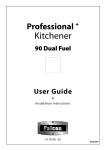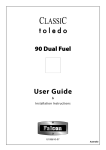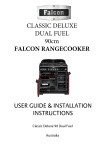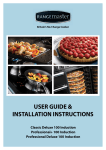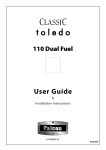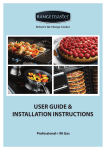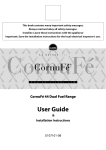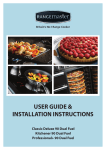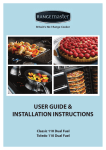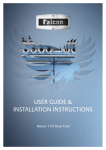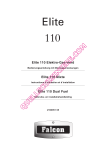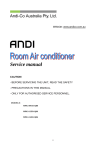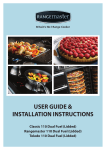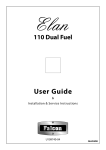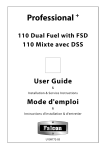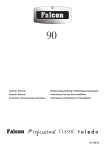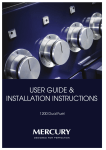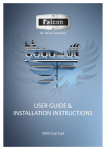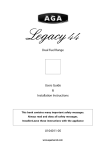Download CLAS110NGFCY-BR User Manual
Transcript
ArtNo.000-0005 Classic logo ArtNo.000-0021 Toledo logo 110 Gas User Guide & Installation Instructions U109936 - 05 Australia Contents 1. 2. 3. Before You Start... 1 Installation 19 Installation and Maintenance 1 Service and Spares 19 Peculiar Smells 1 Dear Installer 20 If You Smell Gas 1 Provision of Ventilation 20 Ventilation 1 Location of Cooker 20 Personal Safety 1 Conversion 20 Cleaning 2 Positioning the Cooker 22 Cooker Overview 3 Moving the Cooker 23 Hotplate Burners 3 Fitting the Stability Bracket and Chain 24 Wok Burner 4 Fitting the Restraining Chain 24 The Wok Cradle 5 Levelling 24 The Griddle 5 Pressure Testing 25 Warmer 5 Electrical Connection 26 The Grill 6 Final Checks 27 The Ovens 7 Final Fitting 27 Operating the Ovens 7 Customer Care 27 The Clock 8 Accessories 10 Main Oven Light Storage Cooking Tips 8. Conversion to Propane Gas 28 10 Conversion from Natural Gas (1.0 kPa) to LPG X Propane (2.75 kPa) 28 10 Hotplate 28 Grill 28 Ovens 29 Gas Connection 29 Pressure Testing 29 Affix Label 29 Servicing 30 Panels 30 Hotplate 31 Controls 32 Grill 33 Ovens 34 Doors 35 11 Tips on Cooking with the Timer 11 General Oven Tips 11 4. Cooking Table 12 5. Cleaning Your Cooker 13 6. 7. 9. Essential Information 13 Hotplate Burners 13 The Griddle 14 Grill 14 Control Panel and Doors 14 Ovens 15 Cleaning Table 16 10. Circuit Diagram 37 17 11. Technical Data 38 Troubleshooting 1. Before You Start... Ventilation This User Guide covers a number of different models. Although some of the illustrations will look different to your particular model the functions will be the same. We hope the meaning is clear. CAUTION: The use of a gas cooking appliance results nn in the production of heat and moisture in the room in which it is installed. Make sure that the kitchen is well ventilated: keep natural ventilation holes open or install a powered cookerhood that vents outside. If you have several burners on, or use the cooker for a long time, open a window or turn on an extractor fan. This appliance is designed for domestic cooking only. Using it for any other purpose could invalidate any warranty or liability claim. In particular, the oven should NOT be used for heating the kitchen – besides invalidating claims this wastes fuel and may overheat the control knobs. nn Personal Safety DO NOT modify this appliance. nn This appliance can be used by children aged from nn 8 years and above and persons with reduced Installation and Maintenance The installation must be in accordance with the relevant instructions in this booklet, with the relevant national and local regulations, and with the local gas and electricity supply companies’ requirements. physical, sensory or mental capabilities or lack of experience and knowledge if they have been given supervision or instruction concerning use of the appliance in a safe way and understand the hazards involved. Children shall not play with the appliance. Cleaning and user maintenance shall not be made by children without supervision. Make sure that the gas supply is turned on and that the cooker is wired in and switched on (the cooker needs electricity). Set the clock to make sure that the oven is functional – see the relevant section in this manual. WARNING: The appliance and its accessible parts nn become hot during use and will retain heat even The cooker should be serviced only by a qualified service engineer, and only approved spare parts should be used. after you have stopped cooking. Care should be taken to avoid touching heating elements. Children less than 8 years of age shall be kept away unless continuously supervised. Always allow the cooker to cool and then switch it off at the mains before cleaning or carrying out any maintenance work, unless specified otherwise in this guide. CAUTION: A long term cooking process has to be nn supervised from time to time. A short term cooking Peculiar Smells process has to be supervised continuously. When you first use your cooker it may give off an odour. This should stop after use. Danger of fire: DO NOT store items on the cooking nn surfaces. Before using for the first time, make sure that all packing materials have been removed and then, to dispel manufacturing odours, turn the ovens to 200 °C and run for at least an hour. To avoid overheating, DO NOT install the cooker nn behind a decorative door. DO NOT use a steam cleaner to clean the cooker. nn Accessible parts will become hot during use and nn will retain heat even after you have stopped Make sure the room is well ventilated to the outside air (see ‘Ventilation’ below). People with respiratory or allergy problems should vacate the area for this brief period. cooking. Keep babies and children away from the cooker and never wear loose-fitting or hanging clothes when using the appliance. If You Smell Gas • • • • • • • DO NOT turn electric switches on or off DO NOT smoke DO NOT use naked flames DO turn off the gas at the meter or cylinder DO open doors and windows to get rid of the gas DO keep people away from the area affected Call your gas supplier Always be certain that the controls are in the OFF nn position when the oven is not in use, and before attempting to clean the cooker. When the oven is on, DO NOT leave the oven door nn open for longer than necessary – otherwise, the control knobs may become very hot. 1 DO NOT use water on grease fires and never pick nn up a flaming pan. Turn the controls off and then Cooking high moisture content foods can create a ‘steam burst’ when an oven door is opened. When opening the oven stand well back and allow any steam to disperse. smother a flaming pan on a surface unit by covering the pan completely with a well fitting lid or baking tray. If available, use a multi-purpose dry chemical or foam type fire extinguisher. Take care that no water seeps into the appliance. ArtNo.324-0001 Steam burst Only certain types of glass, glass-ceramic, earthenware or other glazed containers are suitable for hotplate cooking; others may break because of the sudden change in temperature. Always keep combustible materials, e.g. curtains, nn and flammable liquids a safe distance away from This appliance is heavy so take care when moving it. nn your cooker. Cleaning DO NOT store flammable materials in the storage drawer or near this appliance. nn In the interests of hygiene and safety, the cooker should be kept clean at all times as a build up in fats and other food stuff could result in a fire. DO NOT spray aerosols in the area of the cooker nn while it is on. Clean only the parts listed in this guide. Use dry oven gloves when applicable – using damp gloves might result in steam burns when you touch a hot surface. Do not use a towel or other bulky cloth in place of a glove – it might catch fire if brought into contact with a hot surface. Clean with caution. If a wet sponge or cloth is used to wipe spills on a hot surface, be careful to avoid steam burns. Some cleaners can produce noxious fumes if applied to a hot surface. NEVER operate the cooker with wet hands. nn DO NOT use aluminium foil to cover shelves, linings nn or the oven roof. NEVER heat unopened food containers. Pressure nn build up may cause the containers to burst and cause injury. DO NOT use unstable saucepans. Always make sure nn that you position the handles away from the edge of the hotplate. Never leave the hotplate unattended at high heat settings. Pans boiling over can cause smoking, and greasy spills may catch on fire. Use a deep fat thermometer whenever possible to prevent fat overheating beyond the smoking point. WARNING! Unattended cooking on a hob with fat or nn oil can be dangerous and may result in fire. Never leave a chip pan unattended. Always heat fat nn slowly, and watch as it heats. Deep fry pans should be only one third full of fat. Filling the pan too full of fat can cause spill over when food is added. If you use a combination of oils or fats in frying, stir them together before heating, or as the fats melt. Foods for frying should be as dry as possible. Frost on frozen foods or moisture on fresh foods can cause hot fat to bubble up and over the sides of the pan. Carefully watch for spills or overheating of foods when frying at high or medium high temperatures. Never try to move a pan of hot fat, especially a deep fat fryer. Wait until the fat is cool. Do not use the top of the flue (the slot along the back of the cooker) for warming plates, dishes, drying tea towels or softening butter. 2 2. Cooker Overview DocNo.020-0006 - Overview - 90DF - Prof+ Fig.2-1 A O O O O O O B C E D F ArtNo.212-0002 - 110 Classic ceramic front view The 110 gas cooker (Fig.2-1) has the following features: A. B. C. D. E. F. Fig.2-2 5 hotplate burners including a wok burner and warmer A control panel A grill Left-hand oven Right-hand oven A storage drawer Hotplate Burners The drawing by each of the central knobs indicates which burner that knob controls. Each burner has a Flame Supervision Device (FSD) that prevents the flow of gas if the flame goes out. When the igniter button is pressed in, sparks will be made at every burner – this is normal. Do not attempt to disassemble or clean around any burner while another burner is on, otherwise an electric shock could result. To light a burner, press the igniter button, and push in and turn the associated control knob to the high position as indicated by the large flame symbol (), (Fig.2-2). 3 The igniter should spark and light the gas. Keep holding the knob pressed in to let the gas through to the burner for about ten seconds. Fig.2-3 If, when you let go of the control knob, the burner goes out, then the FSD has not been bypassed. Turn the control knob to the OFF position and wait for one minute before you try again, this time making sure to hold in the control knob for slightly longer. Adjust the flame height to suit by turning the knob counterclockwise (Fig.2-3). If a burner flame goes out, turn off the control knob and leave it for one minute before relighting it. Fig.2-4 Make sure that the flames are under the pans. Using a lid will help the contents boil more quickly (Fig.2-4). Large pans should be spaced well apart. Pans and kettles with concave bases or down-turned base rims should not be used (Fig.2-5). Simmering aids, such as asbestos or mesh mats, are NOT recommended (Fig.2-6). They will reduce burner performance and could damage the pan supports. ArtNo.311-0001 Right pans gas Fig.2-5 You should also avoid using unstable and misshapen pans that may tilt easily, and pans with a very small base diameter, e.g. milk pans, single egg poachers (Fig.2-7). ArtNo.311-0002 Pan with rim The minimum recommended pan diameter is 120 mm. The maximum allowable pan base diameter is 250 mm. DO NOT use cooking vessels on the hotplate that overlap the edges. Fig.2-6 Wok Burner The wok burner is designed to provide even heat over a large area. It is ideal for large pans and stir-frying (Fig.2-8). For heating smaller pans, the aforementioned hotplate burners may be more efficient. Art No. 311-0003 Simmer aids You should wipe the enamel top surface of the cooker around the hotplate burners as soon as possible after spills occur. Try to wipe them off while the enamel is still warm. Fig.2-7 Note: The use of aluminium pans may cause metallic marking of the pan supports. This does not affect the durability of the enamel and may be cleaned off with an appropriate metal cleaner. ArtNo.311-0004 Tipping wok Fig.2-8 ArtNo.311-0005 Wok burner & pan support 4 The Wok Cradle Fig.2-9 The wok cradle is designed to fit a 35 cm wok. If you use a different wok, make sure that it fits the cradle. Woks vary very widely in size and shape. It is important that the wok sits down on the pan support – however, if it is too small, the cradle will not support the wok properly (Fig.2-9). The cradle should be used on the triple ring wok burner only. When you fit the cradle, make sure that it is supported properly on a pan support and the wok is sitting level in the cradle (Fig.2-10). ArtNo.311-0006 Correct wok sizes Fig.2-10 The cradle will get very hot in use – allow plenty of time for it to cool before you pick it up. The Griddle The griddle fits the left-hand pan support, front to back (Fig.2-11). It is designed for cooking food on directly. DO NOT use pans of any kind on it. The griddle surface is non-stick and metal cooking utensils (e.g. spatulas) will damage the surface. Use heat resistant plastic or wooden utensils. ArtNo.311-0007 Wok stand close-up Fig.2-11 DO NOT put it crossways – it will not fit properly and will be unstable (Fig.2-12). nn DO NOT put it on any other burner – it is not nn designed to fit in any of the other pan supports. Position the griddle over the hotplate burners resting on the pan support. Check that it is securely located. The griddle can be lightly brushed with cooking oil before use (Fig.2-13). Light the hotplate burners. Adjust the flame heights to suit. O Preheat the griddle for a maximum of 5 minutes before adding food. Leaving it longer may cause damage. Turn the control knobs towards the low position, marked with the small flame symbol, to reduce the burner flames. O O Fig.2-12 Always leave space around the griddle for the gases nn to escape. NEVER fit two griddles side by side (Fig.2-14). nn After cooking, allow the griddle to cool before cleaning. O O O Warmer On the right of the hob is the warmer. Use the warmer for keeping food warm while the final touches are put to a meal. Turn the control knob counter-clockwise to the ‘On’ position. ArtNo.311-0009 Oil on griddle Fig.2-13 For best results, preheat a covered serving dish for 10 minutes before adding food to it. Use only heat resistant dishes. Fig.2-14 ArtNo.311-0008 Griddle positioning 5 The Grill Fig.2-15 CAUTION: This appliance is for cooking purposes nn only. It must not be used for other purposes, for example room heating. CAUTION: Accessible parts may be hot when the grill nn is in use. Young children should be kept away. ArtNo.330-0003 - Grill pan w handle pulled forwards Open the door and, using the handle, pull the grill pan forward (Fig.2-15). The burner does not glow red when in use; food cooks from the heat of the flame. The first time you light the grill there may be a little smoke given off – this is perfectly normal. Fig.2-16 Operation The grill has a special safety device which stops the flow of gas if the flame goes out. To turn on the grill, press the igniter button and then press and hold the grill control knob to the large flame symbol () for about 10 seconds (Fig.2-16). To heat the right-hand half, turn the knob counter-clockwise. The neon indicator light by the grill control will come on. If, when you release the control knob the burner goes out, then the safety device has not held in. Turn the grill control knob to ‘0’ and wait for one minute. Repeat the operation but hold the button and control knob in for slightly longer. Fig.2-17 The low position, marked with the small flame symbol, is beyond high, not between high and off (Fig.2-17). For best results, slide the grill pan back into the grill chamber and preheat the appropriate part(s) of the grill for two minutes. The grill trivet can be removed and the food placed on it while you are waiting for the grill to preheat. DO NOT leave the grill on for more than a few nn moments without the grill pan underneath it, Fig.2-18 otherwise the knobs may become hot. Once the grill has preheated, slide the grill pan out again. With the trivet back in place with the food on it, slide the pan back into the grill chamber. Make sure that it is pushed right in. ArtNo.331-0002 Grill pan high/low position The grill pan trivet can be turned over to give two grilling positions (Fig.2-18). Do not leave the grill on for more than a few moments, without the grill pan underneath it. Never close the grill door when the grill is on. nn 6 The Ovens ArtNo.323-0003 Bray gas oven burner flame The clock must be set to the time of day before the ovens will work. See the following section on ‘The Clock’ for instructions on setting the time of day. Fig.2-19 References to ‘left-hand’ and ‘right-hand’ ovens apply as viewed from the front of the appliance. Both ovens are gas ovens. Note: Please remember that all cookers vary so temperatures in your new ovens may differ to those in your previous cooker. The Gas Oven Fig.2-20 The two ovens in your cooker use our special ‘Heatflow’ system. As the oven burner is not hidden under the oven base you will see the burner flames at the back of the oven (Fig.2-19). This is perfectly normal. Dishes cooking on the central shelf will cook at the temperature indicated on the knob (Fig.2-20). ArtNo.323-0004 Gas ovens shelves 1 Dishes placed above the central position will be cooked at approximately 10 °C higher, dishes cooked below approximately 10 °C lower (Fig.2-21). You can therefore cook dishes requiring different temperatures at the same time. Fig.2-21 Operating the Ovens Push in and turn the knob controlling the oven to the full on position (Fig.2-22). The oven will light automatically. Turn the oven knob to the desired temperature. For best results preheat the oven for 15 minutes before placing your dishes in it. ArtNo.323-0005 Gas oven shelves 2 Fig.2-22 7 The Clock Fig.2-23 You can use the timer to turn the ovens on and off. The clock must be set to the time of day before the ovens will work. Setting the Time of Day ArtNo.302-0002 - 6BC annotated The 6-button LCD clock is shown in Fig.2-23. When the clock is first connected the display flashes ( 0.00 ) and ( alternately. A Press and hold both the [C] and [D] buttons down (Fig.2-24). Now press the [+] button (or the [–] button) until the correct time shows. B C D E G) F A – Timer knob, B – Adjusting knob Do not forget that it is a 24-hour clock. If you need to reset the cooker, turn off the power supply and wait for a couple of minutes and start again. Fig.2-24 Setting the Minute Minder Press and hold the [C] button (Fig.2-25), and then press the [+] button until the length of time you want to cook for is shown (Fig.2-26). ArtNo.302-0001 - 6-button clock Fig.2-25 You can check the time remaining by pressing [C]. When the beeper sounds cancel it by pressing [C]. Fig.2-26 • ArtNo.302-0003 - 6BC minute minder setting 1 • ArtNo.302-0004 Minute minder setting 2 The ‘cook period’, which is the length of time you want the oven to cook for. The ‘stop time’, which is the time of day you want the oven to stop cooking. To Stop the Ovens Automatically Fig.2-27 ArtNo.302-0005 6BC Stopping the oven 1 Press and hold the ‘stop time’ [E] button (Fig.2-27) and then press the [+] button (or [–] button) until the required ‘stop time’ shows (Fig.2-28). AUTO will show in the display. Fig.2-28 Once the ‘stop time’ is reached, the beeper sounds. To stop the beep turn the oven control knob to 0 first and then press [B] once; press [B] again to return to manual cooking. ArtNo.302-0005a 6BC Stopping the oven 1a To Start and Stop the Ovens Automatically Fig.2-29 Before you set the clock you must have two numbers clearly in mind – the ‘cook period’ and the ‘stop time’. Fig.2-30 Note: You cannot set a start time directly – this is set automatically by setting the ‘cook period’ and the ‘stop time’. ArtNo.302-0006 - 6BC setting the cook time Fig.2-31 Press and hold the [D] button (Fig.2-29) and then press the [+] button (or [–] button) until the required ‘cook period’ shows (Fig.2-30). ArtNo.302-0006 - 6BC setting the cook time Now press and hold the [E] button (Fig.2-31) and then press the [+] button (or [–] button) until the required ‘stop time’ shows (Fig.2-32). Release the buttons. Fig.2-32 AUTO will now show in the display. ArtNo.302-0005 6BC Stopping the oven 1 Set the oven(s) to the required temperature. When cooking is finished the beeper will sound. Turn the oven knob to the OFF position first, and then press the [B] button once to stop the beep; press it again to return to manual cooking. ArtNo.302-0005a 6BC Stopping the oven 1a If you are out, do not worry about the beeper going off, it stops after a while. When you return, turn the oven knob to 0 first, and then press [B] twice to return to manual cooking. 8 AUTO is Showing, You Want to Reset to Manual Cooking Fig.2-34 Fig.2-33 To return to manual cooking from any automatic setting, the ‘cook period’ must be cancelled. Press and hold the [E] button and then press the [–] button until the display reads ( 0.00 ). ArtNo.302-0008 Activating the key lock 1 Press the [B] button to return to manual cooking. ArtNo.302-0009 - Activating the key lock 2 Key Lock Activating the key lock will lock the ovens and they will not come on. Fig.2-35 Fig.2-36 To Activate the Key Lock Make sure that the clock is in manual mode and cancel any active programs. ArtNo.302-0010 Activating the key lock 3 Hold the Minute Minder [C] and Cook period [D] buttons. When ‘On’ appears on the display (Fig.2-33) press the [+] button once. The key symbol [F] and ‘OF’ will now show on the display (Fig.2-34). Release the buttons. ArtNo.302-0011 - 6BC Deactivating the key lock 1 Fig.2-37 The ovens are now locked, as confirmed by the display showing the time of day alongside the key symbol (Fig.2-35). ArtNo.302-0012 Deactivating the key lock 2 To Turn Off the Key Lock Hold the Minute Minder [C] and Cook period [D] buttons. When ‘OF’ appears on the display (Fig.2-36) press the [+] button once. The key symbol [F] will go out and ‘On’ will show on the display (Fig.2-37). Release the buttons. After a few seconds the display will revert to show the time of day. The ovens can now be used normally. 9 Accessories Fig.2-38 Oven Shelves Shelf guard The cooker is supplied with 4 flat shelves (Fig.2-38). The oven shelves can be easily removed and refitted. Pull the shelf forward until the back of the shelf is stopped by the shelf stop bumps in the oven sides (Fig.2-39). Front Lift up the front of the shelf so the back of the shelf will pass under the shelf stop and then pull the shelf forward (Fig.2-40). Fig.2-39 To refit the shelf, line up the shelf with a groove in the oven side and push the shelf back until the ends hit the shelf stop. Lift up the front so the shelf ends clear the shelf stops, and then lower the front so that the shelf is level and push it fully back (Fig.2-41). Fig.2-40 ArtNo.320-0011 Removing the shelf 1 The Handyrack (Left-hand Oven) ArtNo.320-0012 Removing the shelf 2 Fig.2-41 The Handyrack (Fig.2-42) fits to the left-hand oven door only. Food cooking on it is easy to attend to, because it is accessible when the door is open. Fig.2-42 The maximum weight that can be held by the Handyrack is 5.5 kg (12 lb). It should only be used with the supplied roasting tin, which is designed to fit the Handyrack. Any other vessel could be unstable. ArtNo.320-0013 Removing the shelf 3 ArtNo.320-0014 Handyrack on LH door Fig.2-43 It can be fitted at two different heights. One of the oven shelves must be removed and the other positioned to suit. When the Handyrack is used in its highest position, other dishes can be cooked on the bottom shelf position or base of the oven. Fig.2-44 When the Handyrack is used in its lowest position, other dishes can be cooked on the second shelf position or base of the oven. ArtNo.320-0015 Fitting the Handyack 1 To fit the Handyrack, locate one side of it on the door bracket (Fig.2-43). ArtNo.320-0016 Fitting the handyrack 2 Then spring the other side out to clip it onto the other bracket (Fig.2-44). Fig.2-45 Main Oven Light Press the appropriate button to turn the light on (Fig.2-45). ArtNo.320-0027 - Twin oven lights If an oven light fails, turn off the power supply before changing the bulb. See the ‘Troubleshooting’ section for details on how to change the bulb. Storage The bottom drawer is for storing oven trays and other cooking utensils. It can get very warm, so do not store anything in it that may melt or catch fire. Fig.2-46 ArtNo.340-0002 110 removing the drawer The drawer can be removed completely by pulling it right out and up (Fig.2-46). 10 3. Cooking Tips Tips on Cooking with the Timer General Oven Tips If you want to cook more than one dish, choose dishes that require approximately the same cooking time. However, dishes can be ‘slowed down’ slightly by using small containers and covering them with aluminium foil, or ‘speeded up’ slightly by cooking smaller quantities or placing them in larger containers. The wire shelves should always be pushed firmly to the back of the oven. Baking trays with food cooking on them should be placed level with the front edge of the oven’s wire shelves. Other containers should be placed centrally. Keep all trays and containers away from the back of the oven, as overbrowning of the food may occur. Very perishable foods such as pork or fish should be avoided if a long delay period is planned, especially in hot weather. For even browning, the maximum recommended size of a baking tray is 340 mm (13½”) by 340 mm (13½”). DO NOT place warm food in the oven to be timed. nn DO NOT use a timed oven that is already warm. nn DO NOT use the timed oven if the adjoining oven is nn already warm. When the oven is on, do not leave the door open for longer than necessary, otherwise the knobs may get very hot. • Whole poultry must be thoroughly defrosted before being placed in the oven. Check that meat and poultry are fully cooked before serving. Temperature (Gas Mark) Temperature (°C / °F) 1 140 / 275 2 150 / 300 3 160 / 325 4 175 / 350 5 190 / 375 6 205 / 400 7 220 / 425 8 230 / 450 • • • • • Table 3-1 Temperature conversion table 11 Always leave a “finger’s width” between dishes on the same shelf. This allows the heat to circulate freely around them. To reduce fat splashing when you add vegetables to hot fat around a roast, dry them thoroughly or brush lightly with cooking oil. Where dishes may boil and spill over during cooking, place them on a baking tray. The ‘Cook & Clean’ oven liners (see ‘Cleaning Your Cooker’) work better when fat splashes are avoided. Cover meat when cooking. Sufficient heat rises out of the oven while cooking to warm plates in the grill compartment. If you want to brown the base of a pastry dish, preheat the baking tray for 15 minutes before placing the dish in the centre of the tray. 4. Cooking Table The oven control settings and cooking times given in the table below are intended to be used AS A GUIDE ONLY. Individual tastes may require the temperature to be altered to provide a preferred result. Food is cooked at lower temperature in a fan oven than in a conventional oven. When using recipes, reduce the fan oven temperature by 10 °C and the cooking time by 5-10 minutes. The temperature in the fanned oven does not vary with height in the oven so you can use any shelf. Gas Shelf Mark position 3 3-4 30-35 minutes per 500g +30-35 minutes. 6 3-4 20-25 minutes per 500g +20-25 minutes. 3 3-4 30-35 minutes per 500g +30-35 minutes. 6 3-4 25-30 minutes per 500g +25-30 minutes. 3 2-3 35-40 minutes per 500g +35-40 minutes. 6 3-4 25-30 minutes per 500g +25-30 minutes. 3 3-4 20-25 minutes per 500g +20-25 minutes. 6 3-4 15-20 minutes per 500g +15-20 minutes. 3 4 20 minutes per 500g +20 minutes. 6 4 15 minutes per 500g +15 minutes. 3 4 25-30 minutes per 500g. 6 4 20 minutes per 500g. 1-2 3-4 7 2 Large tins 30-35 minutes; individual 10-20 minutes. Fillet 5 2 15-20 minutes. Whole 5 2 15-20 minutes per 500g. Steak 5 2 Steaks according to thickness. 1 4 45-50 minutes per 500g of mixture. Fruit 180 mm tin 2 4 2-2½ hours. Fruit 230 mm tin 2 4 Up to 3½ hours. Madeira 180 mm 3 4 80-90 minutes. Queen cakes 5 2 & 4 or 3 15-25 minutes. Scones 7 2 & 4 or 3 10-15 minutes. 180 mm tin 4 2 & 4 or 3 20-30 minutes. 210 mm tin 4 2 & 4 or 3 30-40 minutes. Shortcrust tarts 6 2&4 Fruit pies 6 2-3 35-45 minutes. Tartlets 6 2-3 10-20 minutes according to size. Puff pastry 7 2-3-4 20-40 minutes according to size. Meringues ‘S’ 3 2-3 hours. Baked egg custard 3 3 45-60 minutes. Baked sponge pudding 5 3 40-45 minutes. 1-2 3 2 to 3 hours. 7 2&4 Food Meat Approximate cooking time 5 4 3 2 1 ArtNo.050-0019 - Albertine SC - Shelf position Oven shelf positions ArtNo.050-0001A - Cooking table - gas ArtNo.050-0001 Gas cooking table Beef (no bone) Lamb Pork Thoroughly thaw frozen joints before cooking. Meat may be roasted at Mk.7 and the cooking time adjusted accordingly. For stuffed and rolled meats, add approximately 10 minutes per 500g, or cook at Mk.6 for 20 minutes then Mk.3 for the remainder. Poultry Chicken Turkey Duck Casserole Yorkshire pudding 2-4 hours according to recipe. For stuffed poultry, you could cook at Mk.6 for 20 minutes then Mk.3 for remainder. Do not forget to include the weight of the stuffing. For fresh or frozen prepacked poultry, follow instructions on the pack. Thoroughly thaw frozen poultry before cooking. Fish Cake Very rich fruit - Christmas, wedding, etc. When two tier cooking leave at least one runner space between shelves. Position the baking tray with the front edge along the front of the oven shelf. Victoria sandwich Desserts Milk pudding Bread 20-30 minutes on a preheated tray. 20-30 minutes. 12 For even browning the maximum size of baking tray recommended is 340mm x 340mm. This ensures free heat circulation. If cooking a two tier load, the trays should be interchanged approximately halfway though the cooking time. 5. Cleaning Your Cooker Essential Information Fig.5-1 A Isolate the electricity supply before carrying out any thorough cleaning. Allow the cooker to cool. C NEVER use paint solvents, washing soda, caustic nn cleaners, biological powders, bleach, chlorine based B bleach cleaners, coarse abrasives or salt. DO NOT mix different cleaning products – they may nn react together with hazardous results. E D All parts of the cooker can be cleaned with hot soapy water – but take care that no surplus water seeps into the appliance. ArtNo.311-0032 Burner layout FSD A – Cap, B – Head, C – Notch, D – Base, E – Electrode Remember to switch on the electricity supply and reset the clock before re-using the cooker. A Hotplate Burners The burner heads and caps can be removed for cleaning. Make sure they are absolutely dry before replacing them. Fig.5-2 B The Single Ring Burners C When refitting the burner head, make sure that the notch lines up with the electrode or hole in the base. Check that the burner head is level and that the cap is fitted centrally on the burner head (Fig.5-1). D The Wok Burner ArtNo.311-0033 Wok burner details FSD The wok burner can also be taken apart for cleaning. When reassembling the wok burner (Fig.5-2), turn over the large base ring and find the ‘D’ shaped area (Fig.5-3). Turn the head until the ‘D’ matches the one on the burner base. Flip the burner over once again and place it on the burner base. E A – Inner burner cap, B – Outer burner head, C – Inner burner head, D – Outer burner head, E – Wok burner base To fit the small inner burner, find the larger electrode notch in the burner rim. Line this up with the white ignition electrode and place the inner burner on the large base ring (Fig.5-4). Fig.5-3 Now fit the two burner caps, making sure that they are seated properly. Check the burner ports are not blocked. If a blockage occurs, remove stubborn particles using a piece of fuse wire. The Wok Cradle Recommended cleaning materials are hot soapy water, a moistened soap pad, cream cleaner or a nylon scourer. The Griddle B Always clean the griddle after use. Allow it to cool completely before removing. Immerse the griddle plate in hot soapy water. Use a soft cloth or, for stubborn stains, a nylon washing up brush. Note: If the griddle is washed in a dishwasher then some dishwasher residue may appear on the back. This is normal and will not affect the performance of your griddle. A ArtNo.311-0016 Fitting the burner inner head A – Electrode notch, B – Ignition electrode 13 Fig.5-4 Grill Fig.5-5 The face of the grill burner will darken with use – this is perfectly normal. Any fat or grease will burn off. Do not try to clean it – the small holes could get blocked and affect burner performance. ArtNo.330-0003 - Grill pan w handle pulled forwards The grill pan can be easily removed for cleaning (Fig.5-5). The grill pan and trivet should be washed in hot soapy water, alternatively, the grill pan can be washed in a dishwasher. After grilling meats or any foods that soil, leave to soak for a few minutes in the sink immediately after use. Stubborn particles may be removed from the trivet by using a nylon brush. Fig.5-6 Before you remove any of the grill parts for cleaning nn make sure that they are cool, or use oven gloves. DO NOT use any abrasive substances. nn Control Panel and Doors Avoid using any abrasive cleaners including cream cleaners. For best results, use a liquid detergent. The same cleaner can be used on the doors or alternatively using a soft cloth wrung out in clean hot soapy water – but take care that no surplus water seeps into the appliance. After cleaning, polish with a dry cloth. Glass Fronted Door Panels (some models) The oven door front panels can be taken off so that the glass panels can be cleaned. Move the cooker forward to gain access to the sides (see the ‘Moving the Cooker’ section under ‘Installation’). Open the oven door slightly and remove the front panel fixing screws from the door sides, 2 each side (Fig.5-6). Carefully lift off the outer door panel. The inside face of the glass panels can now be cleaned – take care not to disturb or wet the door insulation. Note: If the door is triple glazed then the inner two panels are fixed together and should not be separated. After cleaning, carefully refit the outer door panel and replace the side fixing screws. 14 Ovens Thermostat temperature sensor Cleaning is easier if carried out while the oven is still warm. Before cleaning, cover the burner to prevent the burner holes becoming blocked. Fig.5-7 The inside of the oven and inner door panel can be cleaned using an approved cleaner (Table 5-1). Take care not to disturb the oven thermostat temperature sensor at the top of the oven opening (Fig.5-7). The enamelled oven burner trim (Fig.5-8) can be removed for cleaning. The oven burner trim hooks onto the front of the oven burner bracket. When refitting make sure that the trim is in the middle of the front of the oven burner bracket (Fig.5-9). Fig.5-8 ‘Cook & Clean’ Panels The ovens have panels which have been coated with a special enamel that partly cleans itself. This does not stop all marks on the lining, but helps to reduce the amount of manual cleaning needed. ArtNo.323-00011 - Bray burner front shield The ‘Cook & Clean’ panels work better above 200 °C. If you do most of your cooking below this temperature, occasionally remove the panels and wipe with a lint free cloth and hot soapy water. The panels should then be dried and replaced and the oven heated at 200 °C for about one hour. This will make sure that the ‘Cook & Clean’ panels are working effectively. Oven burner trim Fig.5-9 ArtNo.323-0009 - Bray burner shield fitted DO NOT use steel wool, oven cleaning pads, or any other materials that will scratch the surface. Removing the Main Oven Linings Some of the lining panels can be removed for cleaning. You will need to remove the shelves before removing the panels. Fig.5-10 Each side of the oven is fixed with 4 fixing screws. You do not have to remove the screws to remove the oven linings. Simply lift each side panel upwards and they will slide off the screws (Fig.5-10). Then pull them forwards. Once the linings are removed, the oven enamel interior can be cleaned. ArtNo.320-0008 Removing the oven lining 15 Cleaning Table Cleaners listed (Table 5-1) are available from supermarkets or electrical retailers as stated. For enamelled surfaces use a cleaner that is approved for use on vitreous enamel. Regular cleaning is recommended. For easier cleaning, wipe up any spillages immediately. Hotplate Part Finish Recommended Cleaning Method Hob top Enamel or stainless steel Hot soapy water, soft cloth. Any stubborn stains remove gently with a nylon scourer. Griddle plate (some models only) Non-stick surface Allow to cool. Wash in hot soapy water. Do not use abrasive cleaners/scourers. Dishwasher. Warming zone (some models only) Toughened glass Hot soapy water, cream cleaner/scourer if necessary. Outside of cooker Part Finish Recommended Cleaning Method Enamel or paint Hot soapy water, soft cloth. Any stubborn stains, remove gently with a liquid detergent. Stainless steel E-cloth (electrical retailers) or microfibre all-purpose cloth (supermarket). Sides and plinth Painted surface Hot soapy water, soft cloth. Splashback/rear grille Enamel or stainless steel Hot soapy water, soft cloth. Cream cleaner, with care, if necessary. Control panel Paint, enamel or stainless steel Warm soapy water. Do not use abrasive cleaners on lettering. Control knobs/handles & trims Plastic/chrome, copper or lacquered brass Warm soapy water, soft cloth. Brass Brass polish. Toughened glass Hot soapy water, cream cleaner/scourer if necessary. Finish Recommended Cleaning Method Door, door surround and storage drawer exterior. Oven door glass/glass lid Oven and Grill Part Any proprietary oven cleaner that is suitable for enamel. Sides, floor & roof of oven NOT ‘COOK & CLEAN’ OVEN PANELS (see below) Enamel ‘Cook & Clean’ oven panels (some models only) Special enamel that partly cleans itself This surface cleans itself at 200 °C and above, or the panels can be removed and washed with hot soapy water and a nylon brush. Oven shelves, Handyrack, grill trivet, Handygrill rack (some models only) Chrome An oven interior cleaner that is suitable for chrome. Soap filled pad. Dishwasher. Grill pan/meat tin (some models only) Enamel Hot soapy water. Soap filled pad. Dishwasher. CAUTION: CORROSIVE/CAUSTIC OVEN CLEANERS: FOLLOW MANUFACTURER’S INSTRUCTIONS. Do not allow contact with the oven elements. Table 5-1 16 6. Troubleshooting What cleaning materials are recommended for the cooker? See the ‘Cleaning’ section for recommended cleaning materials. The knobs get hot when I use the oven or the grill. Can I avoid this? Yes, this is caused by heat rising from the oven or the grill, and heating them up. Do not leave the oven door open. Never use caustic or abrasive cleaners as these will nn damage the surface. Make sure that the grill pan is pushed right back to the ‘back stop’ when grilling. If there is an installation problem and I don’t get my original installer to come back to fix it who pays? You do. Service organizations will charge for their call outs if they are correcting work carried out by your original installer. It is in your interest to track down your original installer. Always grill with the grill compartment door open. An oven fan is noisy The note of the oven fan may change as the oven heats up – this is perfectly normal. Steam is coming from the oven When cooking foods with high water content (e.g. oven fries) there may be some steam visible at the rear grille. Power failure In the event of a failure in the electrical supply, remember to reset the clock to make sure that the timed oven continues to operate. Take care when opening the oven door, as there may be a momentary puff of steam when the oven door is opened. Stand well back and allow any steam to disperse. Hotplate ignition or hotplate burners faulty Is the power on? Is the clock illuminated? If not, there maybe something wrong with the power supply. Food is cooking too slowly, too quickly, or burning Cooking times may differ from your previous oven. Are the sparker (ignition electrode) or burner slots blocked by debris? Check that you are using the recommended temperatures and shelf positions – see the oven cooking guide. The oven control settings and cooking times are intended to be used only as a guide. Are the burner trim and caps correctly located? See the ‘Cleaning’ section. Individual tastes may require the temperature to be altered either way, to get the results you want. Hotplate burners will not light Make sure that the burner parts have been replaced correctly after wiping or removing for cleaning. The oven is not cooking evenly Do not use a baking tray with dimensions larger than those specified in the section on ‘General Oven Tips’. Check that there is not a problem with your gas supply. You can do this by making sure that other gas appliances you may have are working. If you are cooking a large item, be prepared to turn it round during cooking. Do the burners spark when you push the button? If two shelves are used, check that space has been left for the heat to circulate. When a baking tray is put into the oven, make sure that it is placed centrally on the shelf. If not, verify that the power is on by checking that the clock is illuminated. Grill not cooking properly Are you using the pan and trivet supplied with the cooker? Is the pan being used on the runners, not the floor of the compartment? Is the grill tray pushed fully back to stop? Check that the door seal is not damaged and that the door catch is adjusted so that the door is held firmly against the seal. A dish of water when placed on the shelf should be the same depth all over. (For example, if it is deeper at the back, then the back of the cooker should be raised up or the front lowered.) If the cooker is not level arrange for your supplier to level it for you. Grill ignition faulty Is the power on? Is the clock illuminated? If not there maybe something wrong with the power supply. 17 Oven not coming on Is the power on? Is the clock illuminated? If not, there may be something wrong with the power supply. Fig.6-1 Is the cooker supply on at the isolator switch? ArtNo.324-0005 Oven light bulb Has the time of day been set? Is the key symbol [F] showing in the display to signify that the oven is locked? See the ‘Clock’ section of the instructions for more information on the key lock feature. Fig.6-2 The timed oven is not coming on when automatic cooking Has the oven knob been left in the ‘OFF’ position by mistake? Is the oven locked (see above)? ArtNo.324-0007 Unscrewing the bulb cover Oven temperature getting hotter as the cooker gets older If turning the temperature down using the oven control knob has not worked, or has only worked for a short time, then you may need a new thermostat. This should be fitted by a service person. An oven light is not working The bulb has probably burnt out. You can buy a replacement bulb (which is not covered under the warranty) from a good electrical shop. Ask for a 15 W – 230 V lamp, FOR OVENS. It must be a special bulb, heat resistant to 300 °C (Fig.6-1). Fig.6-3 Turn off the power at the circuit breaker. Effect of hinge adjustment – exaggerated for clarity Fig.6-4 Before removing the existing bulb, turn off the power supply and make sure that the oven is cool. Open the oven door and remove the oven shelves. Centre line of hinge pin Unscrew the bulb cover by turning counter-clockwise. It may be very stiff (Fig.6-2). Taking care to protect your fingers with a glove in case the bulb should shatter, unscrew the old bulb. Screw in the new bulb; screw back the bulb cover. Turn on the circuit breaker and check that the bulb now lights. ArtNo.320-0007 Oven door hinge adjustment 2 Oven door omitted for clarity The oven door is misaligned The bottom hinge of either oven door can be adjusted to alter the angle of the door (Fig.6-3). Loosen the bottom hinge fixing screws and use the notch and a flat bladed screwdriver to move the position of the hinge to set the hinge position (Fig.6-4). Retighten the hinge screws. 18 INSTALLATION Check the appliance is electrically safe and gas sound when you have finished. 7. Installation Service and Spares Firstly, please complete the appliance details below and keep them safe for future reference – this information will enable us to accurately identify the particular appliance and help us to help you. Filling this in now will save time and inconvenience if you later have a problem with the appliance. It may also be of benefit to keep your purchase receipt with this leaflet. You may be required to produce the receipt to validate a warranty field visit. Retailer’s Name and Address Andi-Co Appliance Pty Ltd. 1 Stamford Road, Oakleigh, VIC 3166 Tel: (03) 1300 650 020 Fax: (03) 9569 1450 Email: [email protected] Name of Appliance Classic Toledo 110 Gas Appliance Serial Number* Fuel Type Gas Date of Purchase Installer’s Name, Address and Telephone No. Date of Installation * This information is on the appliance data badge. If You Have a Problem In the unlikely event that you have a problem with your appliance, please refer to rest of this booklet, especially the problem solving section, first to check that you are using the appliance correctly. If you are still having difficulty, contact you retailer. Please Note If your appliance is outside the 12-month warranty period, our service provider may charge for this visit. If you request an engineer to visit and the fault is not the responsibility of the manufacture, our service provider reserves the right to make a charge. Appointments not kept by you may be subject to a charge. Out of Warranty We recommend that our appliances are serviced regularly throughout their life to maintain the best performance and efficiency. The frequency of service will depend on usage – for normal usage once a year should suffice. Service work should only be carried out by a suitably Authorised Person. Spare Parts To maintain optimum and safe performance, we recommend that only genuine spare parts are used. Do not use reconditioned or unauthorised controls. Contact your retailer. 19 INSTALLATION Check the appliance is gas sound when you have finished. Dear Installer Provision of Ventilation Before you start your installation, please complete the details below, so that, if your customer has a problem relating to your installation, they will be able to contact you easily. This appliance is not connected to a combustion products evacuation device. Particular attention shall be given to the relevant requirements regarding ventilation. The room containing the cooker should have adequate air supply. Installer’s Name Install the cooker in a location to allow the complete combustion of gas, proper flueing and to maintain ambient temperature of the immediate surroundings at safe limits, under normal condition. Installer’s Company Location of Cooker ArtNo.050-0011 - Installer information table The cooker may be installed in a kitchen/kitchen diner but NOT in a room containing a bath or shower. Installer’s Telephone Number Note: An appliance for use on Propane must not be installed in a room or internal space below ground level, e.g. in a basement. Conversion Appliance Serial Number All models are supplied set for use on Natural gas. A conversion kit for Propane gas is included with the appliance. See the instructions that are supplied with the conversion kit. After converting the appliance, please attach the Gas Conversion sticker over the appropriate area of the data badge - this will identify the gas type for which the appliance is now set. You must be aware of the following safety requirements & regulations. Before installation, make sure that the local nn distribution conditions (nature of the gas and gas pressure) and the adjustment of the appliance are compatible. The appliance must be installed in accordance with nn the regulations in force and only in a well ventilated space. Read the instructions before installing or using this nn appliance. The regulations and standards are as follows: • AS 5601 – ‘Gas Installations’ In your own interest and that of safety, it is law that all gas appliances be installed by competent persons. Failure to install the appliance correctly could nn invalidate any warranty or liability claims and lead to prosecution. The cooker must be installed in accordance with all local gas fitting regulations, municipal building codes, electrical wiring regulations and any other relevant statutory regulations. WARNING! nn Where this appliance is installed in marine craft, in caravans or in mobile homes it shall NOT be used as a space heater. 20 INSTALLATION Check the appliance is electrically safe and gas sound when you have finished. You will need the following equipment to complete the cooker installation satisfactorily: • Flexible gas hose. • Gas pressure tester/manometer. • Multimeter: For electrical checks. Checking the Parts: 3 pan supports Wok cradle ArtNo.000-0009 Wok ring, cast You will also need the following tools: 1. Electric drill 2. Masonry drill bit (only required if fitting the cooker on a stone or concrete floor) 3. Wall plugs (only required if fitting the cooker on a stone or concrete floor) 4. Steel tape measure 5. Cross head screwdriver 6. Flat head screwdriver 7. 4 mm & 3 mm Allen keys 8. Spirit level 9. Pencil 10. Adjustable spanner 11. 13 mm spanner or socket wrench Griddle plate Grill pan & trivet ArtNo.330-0002 - Grill pan w handle 4 flat shelves Roasting tin ArtNo.324-0003 Handyrack 12. Screws for fitting the restraining chain and bracket Handyrack Splashback (Classic only) ArtNo.324-0004 Roasting tin ArtNo.421-0002 - Splashback Plinth Restraining chain & hook ArtNo.020-0021 - Restraining chain & hook 21 Stability bracket INSTALLATION Check the appliance is gas sound when you have finished. Positioning the Cooker Fig.7-1 The diagram (Fig.7-1) shows the minimum recommended distance from the cooker to nearby surfaces as given in AS 5601. 1. A B D C Overhead – Measurement A The minimum height of any surface above the cooker is 650 mm above the hotplate. E Cookerhoods and exhaust fans shall be installed in accordance with the manufacturer’s instructions. However, in no case shall the clearance between the highest part of the hob of the cooking appliance and a cookerhood be less than 650 mm or, for an overhead exhaust fan, 750 mm. 2. ArtNo.110-0023 - 110 - cooker clearances (AUS) Side Clearances – Measurements B & C Where B, measured from the periphery of the nearest burner to any vertical combustible surface, or vertical combustible surface covered with toughened glass or sheet metal, is less than 200 mm, the surface shall be protected to make sure that the combustible surface does not exceed 65 °C above ambient*. Even with the surface protected, the dimension B should not be less than 135 mm above hotplate level. Fig.7-2 *The fixing of 5 mm thick ceramic tiles to the surface, or attaching fire resistant material to the surface and covering with sheet metal with a minimum thickness of 0.4 mm to a height C of not less than 150 mm above the hotplate, should satisfy this requirement. 130 mm 3. Side Clearances – Measurement D & E Where D, the distance from the periphery of the nearest burner to a horizontal combustible surface is less than 200 mm, then E shall be 10 mm or more, or the horizontal surface shall be above the trivet. If the cooker is near a corner of the kitchen, a clearance of 130 mm is required to allow the oven doors to open (Fig.7-2). The actual opening of the doors is slightly less, but this allows for some protection of your hand as you open the door. We recommend a gap of 1110 mm between units to allow for moving the cooker. Do not box the cooker in it must still be possible to move the cooker in and out for cleaning and servicing. 22 INSTALLATION Check the appliance is electrically safe and gas sound when you have finished. Moving the Cooker Fig.7-3 On no account try and move the cooker while it is plugged into the electricity supply. nn The cooker is very heavy, so take great care. nn We recommend that two people manoeuvre the cooker. Make sure that the floor covering is firmly fixed, or removed, to prevent it being disturbed when moving the cooker around. To help you, there are two levelling rollers at the back, and two screw-down levelling feet at the front. Fig.7-4 Remove the polystyrene base pack. From the front, tilt the cooker backwards and remove the front half of the polystyrene base (Fig.7-3). Repeat from the back and remove the rear half of the polystyrene base. Lowering the Two Rear Rollers To adjust the height of the rear of the cooker, first fit a 13 mm spanner or socket wrench onto the hexagonal adjusting nut (Fig.7-4). Rotate the nut – clockwise to raise – counterclockwise to lower. Fig.7-5 Make 10 complete (360°) turns clockwise. Make sure you lower BOTH REAR ROLLERS. Completing the Move Unfold the rear edge of the cardboard base tray. Open the grill door and right-hand oven door so that you can get a good grip on the bottom of the fascia panel as you move the oven (Fig.7-5). Carefully push the cooker backwards off the base tray. Remove the base tray. ArtNo.010-0004 Moving the cooker Position the cooker close to its final position, leaving just enough space to get behind it. DO NOT use the door handles or control knobs to nn manoeuvre the cooker. 23 INSTALLATION Check the appliance is gas sound when you have finished. Fitting the Stability Bracket and Chain Stability bracket A stability bracket and chain MUST be fitted when nn the cooker is connected to a flexible gas supply. Unless properly installed, the cooker could be tipped by leaning on the door. Injury might result from spilled hot liquids or from the cooker itself. Cooker IMPORTANT: The cooker must be set to the correct height and levelled before the stability bracket is installed. 3 mm min ArtNo.070-0014 - Stability bracket - WallFloor fitting Fitting a Stability Bracket Fig.7-6 Fig.7-7 When fitting a stability bracket please refer to the instructions supplied with the bracket for further details on fitting. Typical floor mounting When fitting a stability bracket (Fig.7-6 and Fig.7-7) adjust the bracket to give the smallest practicable clearance between the bracket and the engagement slot in the rear of the cooker. Outer stability bracket Cooker Fit the bracket so that it engages as far as possible over the chassis of the cooker. Fitting the Restraining Chain 3 mm min Wall The restraining chain MUST be fitted. Floor The length of chain between the appliance and the wall fixing should prevent strain on the gas and electricity connections, but still allow access to unhook the chain when the cooker is pull forward. Typical wall mounting Fig.7-8 Measure the length of chain required. Use the clamp supplied to clamp onto the gas pipe (Fig.7-8). Fix the supplied hook securely to the wall. Restraining chain Levelling ArtNo.011-0007 - Restraining chain (AUS) You are recommended to use a spirit level on a shelf in one of the ovens to check for level. Place the cooker in its intended position taking care not to twist it within the gap between the kitchen units as damage may occur to the cooker or the units. The front feet and rear rollers can be adjusted to level the cooker. To adjust the height of the rear of the cooker use a 13 mm spanner or socket wrench to turn the adjusting nuts at the front bottom corners of the cooker. To set the front, turn the feet bases to raise or lower. 24 INSTALLATION Check the appliance is electrically safe and gas sound when you have finished. Gas Connection Fig.7-9 Must be in accordance with the relevant standards. 600 350 The gas supply needs to terminate with a down-facing threaded fitting ½” connection. The inlet connector is located just below the hotplate level at the rear of the cooker. 100 250 Because the height of the cooker can be adjusted and each connection is different it is difficult to give precise dimensions. Ideally, the house supply connection should be in the shaded area (Fig.7-9). Means of isolation must be provided at the supply point by either an approved quick-connect device or a Type 1 manual shut-off valve. Gas inlet block The hose should be fitted so that both inlet and outlet connections are vertical so that the hose hangs downwards in a ‘U’ shape (Fig.7-9). A flexible connection is supplied with the cooker. If it is necessary to use another hose it must be to AS 1869 class B and be suitable for your gas type. All dimensions in millimetres If in doubt contact your supplier. Screw connect the threaded end of the hose into the gas inlet. After completing the gas connection, check the cooker is gas sound with a pressure test. When checking for gas leakes do not use washing up liquid – this can corrode. Use a product specifically manufactured for leak detection. Natural Gas The adjustable spring loaded gas pressure regulator is present to give a nominal pressure of 1 kPa on Natural Gas. Connect to the Rp ½ inlet on the underside of the pressure regulator. Propane This cooker is supplied ready for use on natural gas. A conversion kit for Propane as is supplied with the cooker – see the ‘Conversion to Propane Gas’ section. Pressure Testing The pressure test point is accessible on the inlet pipe at the rear. Remove the test nipple screw and fit a pressure gauge to the test point. Turn on and light two of the hotplate burners. For Natural Gas cookers the pressure should be 1 kPa. For Propane X cookers the pressure should be 2.54 kPa. 25 Position for gas supply connector INSTALLATION Check the appliance is gas sound when you have finished. Electrical Connection If there is an electrical fault carry out the following checks: WARNING: THIS COOKER MUST BE EARTHED. nn Earth Continuity Check The cooker must be disconnected from the power supply. All external wiring must comply with the local regulations for the Electrical Equipment of Buildings. Connection to the electrical supply can be made with either a plug and socket or be permanently wired via a double-pole switch, having a contact separation of at least 3 mm in all poles. Using an multimeter or ohmmeter to check the resistance, test the leads from any of the cooker’s earth points (e.g. inside electric box cover) – to the earth pin on the cooker’s plug – resistance should be less than 1 Ω. If it is not, check all the earth wires for continuity. Current Operated Earth Leakage Breakers Check that all contacts are clean and tight. Recheck. If the resistance is still greater than 1 Ω there may be a problem, so consult a qualified electrical engineer. The combined use of your cooker and other domestic appliances may cause nuisance tripping, so we recommend that the cooker is protected on an individual RCD (Residual Current Device) or RCBO (Residual Current Breaker with Overload). Polarity Check The cooker must be connected to the power supply. Your meter should be set on 300 V ac scale. IF IN DOUBT, PLEASE CONSULT A SUITABLY QUALIFIED ELECTRICIAN. Test at the cooker terminal block: The appliance is supplied with a 250 V high temperature PVC (85 °C) 3-core cable, 0.75 mm2, 2 m long. If a replacement cable is fitted it must be to this specification. The cooker may possibly be supplied with either a moulded or rewirable plug fitted. Should the plug (where supplied) not fit the socket in your home, it should be removed and replaced with a suitable plug. Note: If a moulded plug is fitted which is not suitable, it must be cut off and disposed of properly. To avoid the risk of electrocution, the moulded plug must not be left where children might find it and plug it into a supply socket. It must not be used for any other appliance. Test leads from A to N. The meter should read about 240 V ac. 2. Test leads from A to E. The meter should read about 240 V ac. 3. Test leads from N to E. The meter should read about 0-15 V ac. If the readings are different from these values there is an electrical fault. Rectify any fault and repeat the test. If necessary repeat the test at the supply system socket/spur – if the fault also occurs at this stage then there is a house system fault that requires attention by the Electrical Authority. Any new plug fitted MUST have insulated terminals. The customer should be warned NOT to use the appliance until this examination has been carried out. The wires should be connected into the terminals of your plug as follows: Earth: 1. To the terminal marked E, or coloured GREEN or GREEN/YELLOW. Neutral: To the terminal marked N, or coloured BLACK or BLUE. Active: To the terminal marked A, or coloured RED or BROWN. When wiring the plug make sure that all strands of wire are retained in each terminal. The flexible mains lead, plug and socket must not be directly exposed to flue products or be in contact with hot surfaces. The lead must not be trapped or pulled taut when the appliance is pushed into position. Plug in the appliance. Turn on the electricity supply. 26 INSTALLATION Check the appliance is electrically safe and gas sound when you have finished. Final Checks Fig.7-10 Hotplate Check Check each burner in turn. There is a Flame Supervision Device (FSD) that stops the flow of gas to the burner if the flame goes out. For each burner, turn the control knob to the solid flame symbol. Press in the control knob. This lets gas through to the burner. Keep holding the knob pressed in and press the igniter button or light with a match. Keep holding the control knob pressed in for about 10 seconds. ArtNo.215-0026 - Handle gaskets fixed Fig.7-11 If, when you let go of the control knob the burner goes out, the safety device has not held in. Wait one minute then try again this time holding the control pressed in for slightly longer. Grill Check Art No 215-0028 - Handrail fascia fixings Turn on the grill control and check that the grill heats up. Oven Check Set the clock as described earlier in the instructions, and then turn on the ovens. Check that the ovens start to heat up. Fig.7-12 Note: The oven light bulb is not included in the guarantee. Turn off the ovens. Final Fitting Fitting the Handles and Handrail (Classic only) Remove the 4 mm Allen screws from the doors (Fig.7-10). Fit the door handles and secure using the 4 mm screws. ArtNo.350-0012 - Securing the plinth The handles should be above the fixings. nn Remove the 4 mm Allen screws from the top corners of the fascia (Fig.7-11). Fit the handrail in position and secure using the 4 mm screws. Fitting the Plinth Loosen the 3 screws along the front bottom edge of the cooker. Hook the central keyhole over the central screw. Twist and fit each end keyhole over their respective screws.Tighten the fixing screws (Fig.7-12). Fitting the Splashback (Classic only) Position the splashback on the rear of the hotplate and secure with the screws supplied. Customer Care Installer: Please complete your details in this Guide, inform the user how to operate the cooker and hand oven the instructions. Thank you. 27 WARNING – SERVICING TO BE CARRIED OUT ONLY BY AN AUTHORISED PERSON Disconnect from electricity and gas before servicing. Check appliance is safe when you have finished. 8. Conversion to Propane Gas DocNo.080-0004 - Gas conversion - 90RM - Tag-fit fascia EVENS Conversion from Natural Gas (1.0 kPa) to LPG X Propane (2.54 kPa) Fig.8-1 This conversion must be performed by a competent nn person, in accordance with these instructions and with the local supply company requirements. Read the instructions before converting this appliance. B Failure to convert the appliance correctly could nn invalidate any warranty or liability claims and lead A ArtNo.311-0010 Injectors to prosecution. C The conversion instructions must be used in nn conjunction with the rest of the appliance A – Injector, B – Internal injector, C – External injector instruction, in particular for information on Standards, cooker positioning, connection, hose suitability, etc. Fig.8-2 When servicing or replacing gas-carrying nn components, disconnect from the gas before ArtNo.102-0015 - Soudillon tap bypass screw starting, and check that the appliance is gas sound after completion. A DO NOT use reconditioned or unauthorised gas nn controls. Disconnect from the electricity supply before nn conversion. Before electrical reconnection, check A – Tap bypass screw that the appliance is electrically safe. Fig.8-3 Hotplate Injectors Remove the burner caps and heads. Remove the old jets (Fig.8-1). Fit the new jets (see the ‘Technical Data’ section at the back of this book for the correct jets). Reassemble in reverse order. ArtNo.333-0005 - 90 Bray gas grill injector - change jet Tap Adjustment Using a pair of long nosed pliers, carefully remove the bypass screw and fit the correct replacement screw (Fig.8-2); see the ‘Technical Data’ for the correct size. Tighten the screw down. Refit the control panel. Grill Injector Lift up the spring retaining the grill holder and slide the jet holder out of the burner venturi (Fig.8-3). Remove the grill jet from the adaptor and fit a new jet; see the ‘Technical Data’ for the correct jets. Refit the jet holder back into the burner venturi. Tap Adjustment Remove the tap bypass screw and fit the new one; see the ‘Technical Data’ for the correct screws. 28 WARNING – SERVICING TO BE CARRIED OUT ONLY BY AN AUTHORISED PERSON Disconnect from electricity and gas before servicing. Check appliance is safe when you have finished. Ovens Fig.8-4 Oven Burner Injector Remove the oven furniture. Remove the securing screw at the right-hand end of the burner assembly (Fig.8-4). The burner is held in place by dimples in the mounting bracket. Slide the burner to the left and lift up, taking care not to disturb the ignition electrode or the flame supervision device electrode positions. Remove the oven jet from the adaptor and fit the new jet; see the ‘Technical Data’ for the correct jets. Reassemble in the reverse order. Oven Thermostat Bypass Remove the thermostat bypass screw and fit the new one in each oven; see the ‘Technical Data’ for the correct screws. Reassemble the cooker. Gas Connection Remove the inlet governor from the gas inlet. Connect the gas hose to the inlet using a ½” female-female connector. Connect the appliance to the gas supply. Check the cooker is gas sound; see the ‘Technical Data’ section for test pressures. Pressure Testing The pressure test point is accessible on the inlet pipe at the rear. Remove the test nipple screw and fit a pressure gauge to the test point. Turn on and light two of the hotplate burners. For Propane X cookers the pressure should be 2.54 kPa. Check the appliance is gas sound. nn Check operation of all the burners. nn Affix Label Stick the appropriate gas label over the natural gas part of the appliance data label. 29 WARNING – SERVICING TO BE CARRIED OUT ONLY BY AN AUTHORISED PERSON Disconnect from electricity before servicing. Check appliance is safe when you have finished. 9. Servicing BEFORE SERVICING ANY GAS CARRYING nn COMPONENTS TURN OFF THE GAS SUPPLY Fig.9-1 Check the appliance is gas sound after completion nn of service. When checking for gas leaks DO NOT use washing up liquid – this can corrode. Use a product specifically manufactured for leak detection. DO NOT use reconditioned or unauthorised gas nn controls. Art No 215-0028 - Handrail fascia fixings Disconnect from the electricity supply before nn servicing, particularly before removing any of the Fig.9-2 following: control panel, side panels, hotplate tray or any electrical components or covers. A Before electrical reconnection, check that the nn appliance is electrically safe. B C 1 Panels 1.1 To Remove the Control Panel DISCONNECT FROM THE ELECTRICITY SUPPLY. Classic – Removing the Control Panel Remove the handrail. Now remove the 2 cross-headed screws hidden behind the handrail end brackets (Fig.9-1). Pull off all the control knobs and remove the fixing screws underneath the control panel. Lift the control panel and pull forwards, taking care not to damage or strain the wiring. A – Flue grill, B – Cooker backsheet, C – Earthing/fixing screws Fig.9-3 A B Toledo – Removing the Control Panel Pull off all the control knobs and remove the fixing screws underneath the control panel. Slide the control panel to the right and then pull forwards, taking care not to damage or strain the wiring. C A – Flue grill, B – Cooker backsheet, C – Earthing/fixing screws 1.2 To Remove the Side Panels DISCONNECT FROM THE ELECTRICITY SUPPLY. Remove the control panel (see 1.1). Pull the cooker forward. Remove the 4 retaining screws for each panel (1 at the front base, 1 on the top and 2 at the rear). Reassemble in reverse order. 30 WARNING – SERVICING TO BE CARRIED OUT ONLY BY AN AUTHORISED PERSON Disconnect from electricity before servicing. Check appliance is safe when you have finished. 2 2.4 To Replace a Hotplate Burner Electrode Hotplate DISCONNECT FROM THE ELECTRICITY SUPPLY. Lift off pan supports and remove the burner cap. Remove the screw holding the electrode. Pull the electrode vertically up sufficiently to grip the lead between thumb and forefinger. Pull off the electrode, but keep hold of the lead. Fit the new electrode to the lead. Fix the electrode in the burner with screw. Replace the burner cap. Check the burner ignition. Replace the pan supports. 2.1 To Remove the Hotplate Pull the cooker forward to gain access to the rear. Left-hand tray From the rear remove the screws securing the flue grill to the hotplate tray. Remove pan supports, burner heads and caps. Remove the 4 screws and washers holding the hotplate tray to the frame. Raise the front of the hotplate then withdraw. Right-hand tray From the rear remove the screws securing the flue grill to the hotplate tray. If the left-hand hotplate has not been removed, slacken the screws holding the left-hand tray. Remove the pan support, burner head, caps and trim rings. Remove the screws holding the wok burner to the hotplate. Remove the 2 screws and washers holding the right-hand tray to the frame. Press the wok burner down slightly and, taking care not to damage the wok burner electrode, slide the tray about 30 mm to right to clear the locating brackets on the right-hand side. Lift tray slightly at the front and taking care not to stress the warmer/lead junction, disconnect the leads to the warmer neon and separate the leads at the piggybacks. Withdraw the hotplate. Reassemble in the reverse order, making sure that the leads are reconnected. When replacing the right-hand hotplate take care not to damage the ignition electrode of the wok burner. It is important that the rear fixing screws are refitted as they from part of the cooker earthing. On some models there is a separate plate (Fig.9-2). On others it is a tag on the cooker backsheet (Fig.9-3). It is important that the tag is on the outside and that both fixing screws are fitted. Check for correct burner operation. 2.5 To Replace a Hotplate Burner DISCONNECT FROM THE ELECTRICITY SUPPLY. Remove the hotplate tray (see 2.1). The burners (except the right-hand wok burner) are mounted on support struts. For these burners, disconnect the burner feed pipes at the burner. Remove the screws at the front and rear holding the support struts. Lift the strut and burners clear. The burners are fixed to the support struts with 2 screws. Remove the appropriate burner and fit the new one. Reassemble in reverse order. Check that the burner operation is satisfactory. Right-hand Wok Burner Disconnect the burner feed pipes at the burner. Fit the new one and reassemble in reverse order. Check that the burner operation is satisfactory. 2.6 To Change the Warmer Neon DISCONNECT FROM THE ELECTRICITY SUPPLY. Remove right-hand hotplate (see 2.1). Carefully turn the hotplate upside down on a suitable flat surface. Remove the 2 screws holding neon bracket to warmer frame. Fit the new neon and bracket assembly. Reassemble in reverse order and check for correct operation. 2.7 To Change the Warmer 2.2 To Replace the Hotplate Control Taps DISCONNECT FROM THE ELECTRICITY SUPPLY. Remove the right-hand hotplate (see 2.1). Fit the new right-hand hotplate and reassemble in reverse order. Check the burner and warmer operation is satisfactory. DISCONNECT FROM THE ELECTRICITY SUPPLY. BEFORE SERVICING ANY GAS CARRYING nn COMPONENTS, TURN OFF THE GAS SUPPLY. Remove the control panel and hotplate (see 1.1 & 2.1). Unplug the FSD lead from the rear of the tap. Undo the compression fitting at the rear of the tap and remove the fixings that secure the tap to the gas rail. Disconnect the ignition switch wiring. Remove the tap. Remove and discard the gasket seal. Fit the new gasket seal to the replacement tap. Reassemble in reverse order. Check that the appliance is gas sound. Verify the hotplate ignition. 2.3 To Change a Hotplate Burner Injector Remove the burner cap and head. Remove the old injector. Fit the new injector. Reassemble in reverse order. Check the appliance is gas sound. 31 WARNING – SERVICING TO BE CARRIED OUT ONLY BY AN AUTHORISED PERSON Disconnect from electricity before servicing. Check appliance is safe when you have finished. 3 Fig.9-4 Controls 3.1. To Replace the Ignition or Light Switch DISCONNECT FROM THE ELECTRICITY SUPPLY. Remove the control panel (see 1.1). Note: The old switch may be destroyed during removal. Remove the old switch from its bezel by gripping the switch body behind the control panel and twisting sharply. Remove the switch bezel by folding back the locking wings and pushing forward. To fit the new bezel to the control panel: first line up the raised key on its body with the cut-out in the control panel and push it in from the front. Assemble the new switch to the bezel by lining up the key sections and pushing home. Fit the new button by pushing in from the front. Replace the control panel in the reverse order and test for correct operation. 3.2 To Replace the Clock DISCONNECT FROM THE ELECTRICITY SUPPLY. Remove the control panel (see 1.1). Pull off the timer control buttons. Undo the timer fixing screws and remove the timer/ mounting bracket assembly from the control panel. Remove the timer from its mounting bracket by depressing the plastic lugs on the timer case, and at the same time pulling the unit forward. Reassemble in reverse order. When replacing the leads, refer to the wiring diagram. Check the operation of the timer. 3.3 To Change the Warmer Switch DISCONNECT FROM THE ELECTRICITY SUPPLY. Remove the right-hand hotplate tray (see 2.1). Disconnect the wiring from the warmer switch. Remove the 2 screws holding switch to mounting panel, taking care not to lose the switch rotation limiter (Fig.9-4). Fit the new switch and reassemble in reverse order. Check for correct operation. 3.4 To Change the Ignition Generator DISCONNECT FROM THE ELECTRICITY SUPPLY. Pull the cooker forwards to gain access to the cover box at the rear of the cooker. Remove the screws securing the cover and lift clear. Noting the position of the leads, pull off all the leads to the generator. Slacken the 2 screws holding generator to cooker and remove the generator. Fit the new generator to the cooker and replace the leads. Refer to the wiring diagram and reassemble in reverse order. Check the ignition performance. 32 WARNING – SERVICING TO BE CARRIED OUT ONLY BY AN AUTHORISED PERSON Disconnect from electricity before servicing. Check appliance is safe when you have finished. 4 Grill Spring clip BEFORE SERVICING ANY GAS CARRYING COMPONENTS, TURN OFF THE GAS SUPPLY. Fig.9-5 4.1 To Change the Grill Control Tap DISCONNECT FROM THE ELECTRICITY SUPPLY. Remove the control panel (see 1.1). Lift up the righthand hotplate tray front (see 2.1). Undo the gas connection to rear of valve and remove the screw(s) securing tap to gas rail. Remove old tap, discard the old gasket/seal. Fit the new gasket/seal to the new tap. Reassemble in reverse order. Check the tap is adjusted for the correct gas. Check the appliance is gas sound. Grill injector holder Fig.9-6 4.2 To Change the Grill Injector A DISCONNECT FROM THE ELECTRICITY SUPPLY. Remove the control panel (see 1.1). Lift up the spring clip retaining the grill injector holder and slide the injector holder out of the burner venturi (Fig.9-5). Remove the grill jet from adaptor and fit a new jet (see the ratings table for correct jet). Put the injector holder back in the burner venturi. B D C ArtNo.160-0008 - Bray grill burner fixing screws 4.3 To Change the Grill Burner DISCONNECT FROM THE ELECTRICITY SUPPLY. Remove the grill injector (see 4.2). Remove the 2 screws holding the front shield and remove the shield. Turn the grill venturi clockwise to clear the front cross-member, lift up and remove (Fig.9-6). For models with ignition disconnect the electrode lead and remove the screw holding the plate around the grill electrode. Support the grill burner from below and remove the 2 screws (under the foil wrap) securing grill burner to the top of grill chamber. Remove the grill burner. Reassemble in reverse order taking care not to damage the grill electrode (where fitted). A – Grill electrode plate fixing screw, B – Position of grill burner fixing screws, C – Front shield fixing screws, D – grill venturi 4.4 To Change the Grill Electrode DISCONNECT FROM THE ELECTRICITY SUPPLY. Remove the grill burner (see 4.3). Withdraw the electrode and pull off the electrode lead. Fit the lead to the new electrode. Reassemble in reverse order and check ignition is satisfactory. 33 WARNING – SERVICING TO BE CARRIED OUT ONLY BY AN AUTHORISED PERSON Disconnect from electricity before servicing. Check appliance is safe when you have finished. 5 Fig.9-7 Fig.9-8 Ovens 5.1 To Remove an Oven Thermostat DISCONNECT FROM THE ELECTRICITY SUPPLY. Remove the right-hand hotplate tray (see 2.1); for the left-hand oven remove the left-hand side panel (see 1.2). Open the appropriate oven door. Unclip the thermostat phial from the clips at the front of the oven roof. Disconnect tubing nut at rear of thermostat and remove the screw(s) securing the thermostat to the gas rail. Remove thermostat and gasket/seal. When fitting replacement thermostat use the new gasket/seal supplied. Make sure that the capillary is clipped to the bracket at the front of the oven roof. Reassemble in the reverse order. Check the appliance is gas sound. Check the operation of the thermostat. Oven burner assembly fixing screw Tube nut 5.2 To Remove the Oven Burner Open the oven door and remove the oven shelves. Remove the securing screw at the right-hand end (Fig.9-7). The burner is held in place by dimples in the mounting bracket. Slide the burner to the left and lift up, taking care not to disturb or damage the 2 electrodes. Reassemble in reverse order. Check the 2 electrodes have not been disturbed. 5.3 To Change the Oven Burner Assembly Open the oven door. Disconnect the tube nut and tubing. Remove the screw holding the oven burner assembly and withdraw complete assembly (Fig.9-8). Remove the oven burner. Fit the oven burner to new assembly. Replace the complete assembly in the oven. Reconnect the tube and secure with the tube nut. Check the appliance is gas sound. Check the flame safeguard device operation 5.4 To Change the Oven Burner Injector Remove the oven burner (see 5.2). The injector is now accessible. Remove the old jet and fit the new one. Reassemble in reverse order. Check that the flame safeguard device probe has not been disturbed. 5.5 To Change an Oven Programming Flame Safeguard unit DISCONNECT FROM THE ELECTRICITY SUPPLY. Pull the cooker forwards to gain access to the cover box at the rear of the cooker. See ‘Moving Your Cooker’ in the Installation section. Remove the screws securing the cover and lift clear. Noting their positions, pull off all the leads to the PFS control unit. Slacken the 3 screws holding the control unit to the cooker and remove. 34 WARNING – SERVICING TO BE CARRIED OUT ONLY BY AN AUTHORISED PERSON Disconnect from electricity before servicing. Check appliance is safe when you have finished. Fit the new PFS unit to the cooker and replace the leads. Refer to the wiring diagram and reassemble in the reverse order. Check the performance. Fig.9-9 Fig.9-10 5.6 To Change the Oven Solenoids DISCONNECT FROM THE ELECTRICITY SUPPLY. Move the cooker forward to gain access to the rear. See ‘Moving Your Cooker’ in the installation section. Remove the screws securing the cover and lift clear. Disconnect the solenoid leads and remove the earth lead from the earth screw. Unclip the wires from the cable ties. Disconnect the pipe tube nuts to the solenoid unit. Unscrew the locking nut from the end connector and the remove solenoid unit. Fit the new unit to mounting bracket and fix in place with locking nut. Refit the tube nut connections. Replace the leads (refer to the wiring diagram). Replace the wires in cable ties. Check the appliance is gas sound. Refit the cover box. Check for the correct operation of the solenoids. 1 ArtNo.320-0001 Door hinges 5.7 To Change an Oven Electrode DISCONNECT FROM THE ELECTRICITY SUPPLY. Remove the oven burner (see 5.2). Remove the screw and nut securing the electrode to the burner. Pull the lead from back of electrode and fit to the new electrode. Fit the new electrode to the burner. Reassemble in reverse order. Check the ignition. 6 Doors 6.1 To Remove the Grill Door Remove the left-hand side panel (see 1.2). Remove the plinth (4 screws) and the central vertical cover (5 screws). Remove the 2 countersunk screws (1 each side) securing the grill hinge arms to the front of the grill chamber. Note: The arms are spring tensioned. Carefully remove the grill door. Retain the gaskets. Reassemble in reverse order, making sure that the gasket is fitted between the hinge arm and the front of the grill chamber. 6.2 To Replace an Oven Door Open the oven door. Support the door and loosen the 2 screws securing the upper hinge and gasket to the cooker front (Fig.9-9). The door is heavy, so take care. nn Support the door and remove the screw nearest the hinge pin (Fig.9-10). Swing the hinge up and away from the door hinge pin. Lift the door away from the lower hinge and remove. Reassemble in reverse order. 35 2 ArtNo.320-0001 Door hinges WARNING – SERVICING TO BE CARRIED OUT ONLY BY AN AUTHORISED PERSON Disconnect from electricity before servicing. Check appliance is safe when you have finished. Fig.9-11 6.3 To Adjust an Oven Door Angle Centreline of hinge pin The bottom hinge of either oven door can be adjusted to alter the angle of the door (Fig.9-11). Loosen the bottom hinge fixing screws and use the notch and a flat bladed screwdriver to move the position of the hinge to set the hinge position (Fig.9-12). Retighten the hinge screws. 6.4 To Replace an Oven Door Outer Panel ArtNo.320-0007 Oven door hinge adjustment 2 Oven door omitted for clarity Move the cooker forwards to gain access to the sides. Open the oven door slightly and remove the 4 front panel fixing screws from the door sides (2 each side), (Fig.9-13). Carefully lift off the outer door panel. Remove the door handle from the panel by unscrewing the 2 retaining nuts. Fit the door handle to the new panel. Fit the panel to the door. Reassemble in reverse order. Fig.9-12 ArtNo.320-0006 Oven door hinge adjustment 1 6.5 To Change the Oven Door Latch Remove the outer door panel (see 6.4). Remove screws ‘B’, which hold the latch assembly to the inner door panel (Fig.9-14). Fit the new catch and reassemble in reverse order. Check the door operation. Effect of hinge adjustment – exagerrated for clarity Fig.9-13 6.6 To Adjust an Oven Door Catch Keep Open the oven door, slacken off the locknut at the base of the keep, and screw in or out as required until the required fit is obtained. Retighten the locking nut (Fig.9-15). 6.7 To Change an Oven Door Seal ArtNo.320-0002a Proplus oven door side screws Fig.9-14 Open the oven door. The seal is held in place by small hooks on the rear face. At the corner, pull the seal diagonally away from the door centre until that hook is released (Fig.9-16). Proceed to the next hook and release it in a similar way, and so on. Use force if the hooks are stiff, as the old seal will be discarded. When fitting the new seal, position the seal join at the bottom. Hook the new seal in one of the corner holes of the door, and proceed round the door, snapping in each hook in turn. Fig.9-15 ArtNo.320-0004 Oven door keep B ArtNo.320-0003 Oven door latch Fig.9-16 ArtNo.320-0005 Oven door rubber seal 36 10. Circuit Diagram or or y B A or or y C y E D r br F v w br br b br b G P2 4 P1 1 b br br br r b r P3 H r y b b b J I c c y 1 Active br b Sensor b v 1 N L v N L b N JT2 c c b c b M w c L b br br b O P br b br JT2 1 JT1 Spark br ArtNo.080-0024 Classic 110 circuit diagram (Aus) b v JT1 Con7 Spark K b Con7 Earth Con6 Sensor b Con6 Neutral b or 1 b b b br br br b b Key The connections shown in the circuit diagram are for single-phase. The ratings are for 230 V 50 Hz. Key Description Code Colour A Right-hand oven stat switch b Blue B Left-hand oven stat switch br Brown C Right-hand oven light switch bk Black D Left-hand oven light switch or Orange E Clock r Red F Ignition switch v Violet G Warmer switch w White H Neon y Yellow I Warmer g/y Green/Yellow J Right-hand oven light bulb gr Grey K Spark generator L Light-hand oven light bulb M Flame safeguard unit N Flame safeguard unit O Solenoid assembly P Solenoid assembly 37 11. Technical Data ArtNo.105-0008 - Technical data - 90 induction - Elan This cooker is designed for use on Natural Gas, although a conversion for LP (LPG X Propane (2.54 kPa)) gas is packed with the cooker. INSTALLER: Please leave these instructions with the User. DATA BADGE LOCATION: Cooker back, serial number repeater badge below oven door opening. COUNTRY OF DESTINATION: Australia Connections Gas (Rp ½ at rear right-hand side) Natural gas Propane Electric 1 kPa 230 V 50 Hz 2.54 kPa See the appliance badge for test pressures. Dimensions Overall height minimum 900 mm maximum 925 mm Overall width 1100 mm Overall depth 600 mm (to fascia); 650 mm (over handles) Minimum space above the hotplate 650 mm Refer to 'Positioning the Cooker'. Ratings Natural Gas 1.0 kPa Hotplate Injector Wok burner 15.2 MJh-1 Large Burner 12.3 MJh-1 Medium Burners internal 112 LP Gas 2.54 kPa Bypass Injector internal 66 Bypass 90 15.0 MJh-1 165 80 12.0 MJh-1 89 41 6.2 MJh-1 115 56 6.2 MJh-1 67 33 Small Burner 3.7 MJh 92 48 -1 3.3 MJh 45 25 Ovens 9.5 MJh-1 160 70 9.5 MJh-1 87 79 Grill 10 MJh 280 77 10 MJh 100 96 Warmer -1 -1 external 164 -1 external 91 160 W Maximum total electrical load at 230 V (approximate total including oven lights, oven fan, etc.) : 0.18 kW. 38 54 Notes 39 Notes 40 Notes 41 Clarence Street, Royal Leamington Spa, Warwickshire, CV31 2AD, England. Tel: +44 (0) 1926 457400 Fax: +44 (0) 1926 450526 E-mail: [email protected]












































